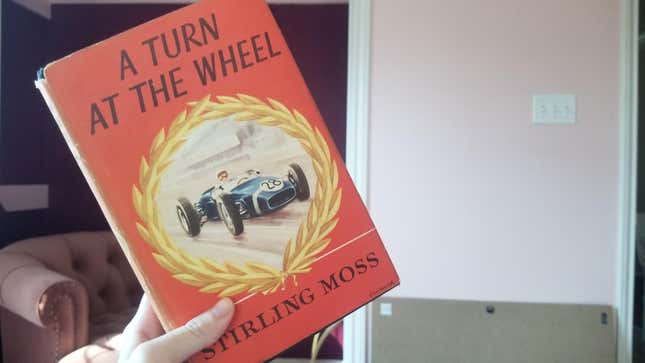
The name “Stirling Moss” will resonate with any motorsport fan familiar with Formula One’s golden age of Grand Prix Racing — but it’s rare to hear directly from the man himself at length. And that’s exactly what we get in Moss’ A Turn at the Wheel.
(Welcome back to the Jalopnik Race Car Book Club, where we all get together to read books about racing and you send in all your spicy hot takes. In honor of being trapped indoors, I’ve made the reading a little more frequent; every two weeks instead of every month. This week, we’re looking at A Turn at the Wheel by Stirling Moss.)
Now, I want to start by saying that I have no idea how this book was written. Did Moss sit down to write it himself, or was it put together by someone else based on recordings of conversations with Moss? I’m not totally sure — but whatever the case, Moss’ voice rings through this entire book so strongly that it feels as if he’s sitting next to you and walking you through the four years of his racing career that A Turn at the Wheel requires.
Why do I think this? Well, some parts of the book are... not boring, but very procedural. Moss kept avid notes of his life in a journal, which means many race weekends are punctuated with Moss recapping his exact lap times and the lap times of his competitors. On its face, some of the book isn’t particularly rich with excitement.
But I think this is a book that will appeal to anyone who’s familiar with Formula One, who recognizes that the late 1950s and early 1960s were nothing like the racing we know today but who may not totally appreciate how.
In that case, it’s the subtext that’s really interesting — the difference between the brief lap times at Monza and the eternal times at the Nürburgring, the strange politics that dictated racing’s future in places like Cuba, the fact that drivers supplemented their F1 careers by racing just about anywhere, his random appearances in America to set speed records, and the two ill-fated Grands Prix in the United States at Sebring and Riverside. Some of Moss’ reporting on these events is extremely cut-and-dry, but there were a lot of times where I found myself pausing to reflect on what I’d just read to really appreciate how different that era was from everything that came before it.
One of the more interesting facets of the book, too, was Moss’ response to the frequent driver deaths that took place during this four-year period: Luigi Musso, Peter Collins, Stuart Lewis-Evans, Ivor Bueb, Harry Schell, Alan Stacey, and so many more. Until their deaths, Moss wrote about them pretty matter-of-factly, so there was no indication that they would soon be dead. It was all lap times and camaraderie shared between the drivers of the era. And suddenly, in the next paragraph, that driver would be dead.
It was disorienting. Moss offered brief eulogies for some of the drivers, reflecting on the cruelty of the sport and the fact that he would miss the men he’d lost. But it was also fascinating to hear his rationalizations — the way he evaluated the cause of the accidents, how he compartmentalized it to continue racing.
The best example I can give is of Moss’ own accident at the 1960 Belgian Grand Prix. He describes how he shouldn’t have crashed there, how he was immediately terrified by the fact that the accident was caused by driver error. Moss argued that, had the accident been his fault, he would have been too horrified to continue racing because the corner was quite an easy one to maneuver. It’s the first time in the book you hear him speak with pure anxiety about racing.
But when he discovers that the crash was the result of faulty machinery, Moss’ entire attitude changes. Without hesitation, he’s ready to get back racing, because machinery errors are acceptable. Driver error is not.
While I don’t know that I’d recommend this book to anyone looking to explore the golden era of F1 for the first time, I would absolutely say that you need to read it if you have a little familiarity with that time period. This is a book whose main points live in the subtext you’ll find between lap times and international jaunts — and if you can comb them out, you’ll find one of the more enriching books ever written by a driver.
And that’s all we have for this week’s Jalopnik Race Car Book Club! Make sure you tune in again on February 28, 2022. We’re going to be reading Senna Versus Prost: The Story of the Most Deadly Rivalry in Formula One by Malcolm Folley.